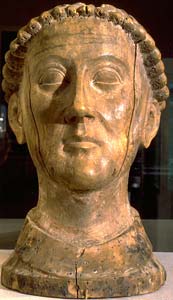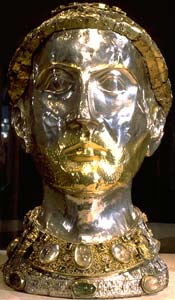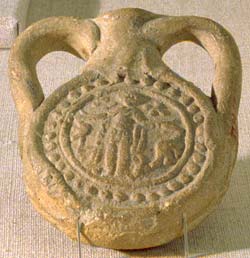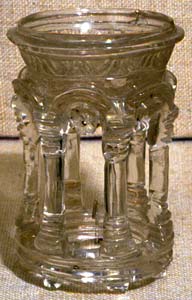 |
 |
 |
| Lecture 19. Pilgrimage |
|
The purpose of pilgrimage is to make direct personal contact with a place associated with Christ or the saints. In the latter case, to obtain favor through the mediation and intercession of the saints honored or buried there; to render thanks for favors received or to requite a penitential pilgrimage. An example of a thank-you pilgrimage may be seen in the pilgrimage of Richard I Lionheart. After his release from a German prison following the Third Crusade, hr visited the tomb of Edward the Confessor at Westminster. Offenders in capital cases were sometimes compelled to go on pilgrimages that lasted years. Pilgrims needed to obtain written authorization from a bishop; the pilgrim might receive a special liturgical blessing before setting out; he might put on special dress resembling that of a penitent with broad-brimmed hat, wallet or pouch, long cane or pilgrim's staff. One should not underestimate the grim hardships and dangers (see the Pilgrim's Guide). There developed a network of pilgrims' roads with hospices for accommodation. Para-monastic orders were created to help pilgrims -- e.g. the Knights of Saint James in Spain; the Knights Templar, the Knights of Saint John, etc. The numbers might be very considerable - -200,000 were said to have gone to Rome for the first Holy Year in 1300. The ritual pilgrim might bring an ex voto to the shrine which he would leave there -- e.g. a wax or metal effigy of a limb that had been healed. The pilgrim might make an offering of money or an in-kind gift at the shrine. The final stretch of the pilgrimage was often completed on hands and knees. All-night vigils were sometimes undertaken. Bodily cures were often sought. Some pilgrims would settle for an extended stay at the site. Those returning would seek to take a momento.
Pilgirmage cults developed through a combination of popular zeal and clever clerical manipulation. Earliest pilgrims travelled to the places associated with Christ's life, ministry and death. Later pilgrims journeyed to the places where the martyrs met their end or where confessors ("witnesses" of Christ) had ministered. The martyrs and confessors were mediators. Pilgrimages might also develop to the place where some vision of epiphany had revealed itself. Many sites for Christian pilgrimage had pagan roots. I. Early Christian Pilgrimage to the Holy Land and Egypt Early Christian pilgrimages would be undertaken to venerate places sanctified by the life of Christ -- to tread in Christ's footsteps. After the period of Constantine, interest developed in the sites associated with the discovery of the relics of the true cross. Such events are described by Eusebius of Caesarea.
The most celebrated pilgrim to the Holy Lands was Saint Jerome who resided there for more than 30 years and whose presence encouraged the development of monastic life. II .Pilgrimage to Rome The tombs of Saint Peter and Saint Paul (Feast Day: June 29) were the principal objects for pilgrims to Rome. Rome was rich in sites of martyrdom. Graffiti on the walls of catacombs indicate the early development of pilgrimage to the city. After the Peace of the Church such pilgrimages increased -- the fourth century saw architectural restorations in the catacombs in order to accommodate pilgrims. III. Santiago de Compostela, Spain After the Resurrection of Christ, the Apostles traveled through the world preaching the word of the Lord and converting people to Christianity. According to legend, James, the son of Zebadee and brother of John the Evangelist, was the apostle who went to Spain. James in Spanish is Iago or Diego. The principal miracle associated with James's residence in Spain was the appearance at Zaragoza of the Virgin Mary standing on a stone column -- commemorated in the Church of Our Lady of the Pillar. After many years of missionary activity James returned to Jerusalem where he suffered martyrdom under Herod in 44 AD. His disciples spirited away his body and set sail from Jaffa to Spain. As the ship drew near to the coast a horseman riding beside the sea was carried by his bolting horse into the waves -- but instead of drowning the horse and rider came to the surface covered in scallop shells. After landing with the body, the disciples were received by a local noblewoman called Lupa who directed them to a mountain with a cave. The dragon occupying the cave was defeated by the disciples and a resting place found for the body. Two disciples (Theodosius and Anastasius) remained to guard the tomb. The Christian community, however, was dispersed in the persecutions of the Emperor Diocletian and the site of the tomb was lost. Christianity re-emerged with the Visigoths and even during the Moorish occupation Christianity was tolerated. In northern Spain a powerful Christian kingdom emerged -- Asturian. Finally in 813 a star of great magnitude hovering over an oak grove led a shepherd to discover a curious ruined building. He rushed to report the find to the local bishop. Bishop Teodomiro went to the spot and identified the ruins as the tomb of Saint James and his disciples. Alfonso II, king of Asturias, left his capital at Oviedo to go to the "field of the star" -- thus becoming the first pilgrim to the place that would become named "Santiago de Compostela." A lavish new church was built and the episcopate situated there. Saint James became the leader of the Christian drive against the Islamic occupiers of Spain. At the battle of Clavejo he appeared beside the king to rally the Asturian soldiers. Battle cry of "Santiago matamoros" We know a great deal about the pilgrimage cult thanks to the "Pilgrim's Guide" in the Codex Calixtinus composed by a French man around 1130. The four great routes followed Roman roads supplemented with new construction. Note: a pilgrim walking from Paris would require15 weeks to complete the journey.
|




